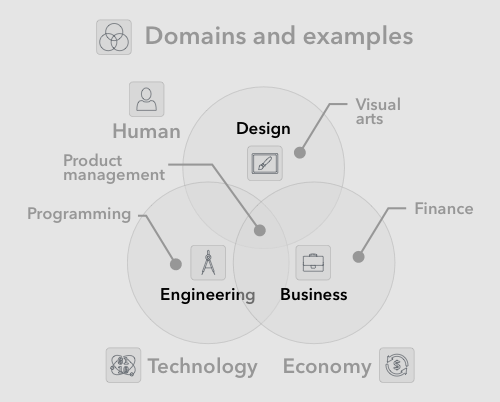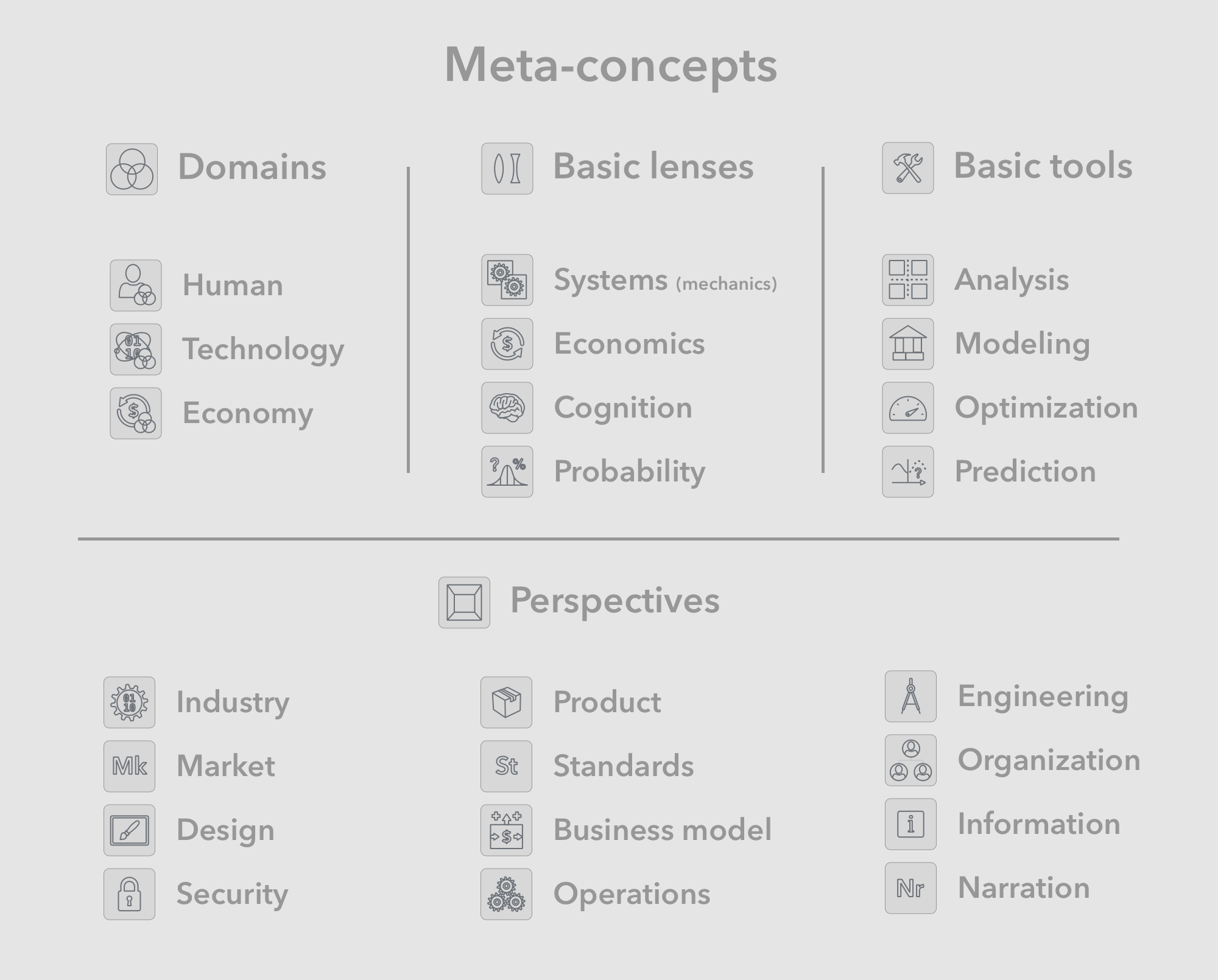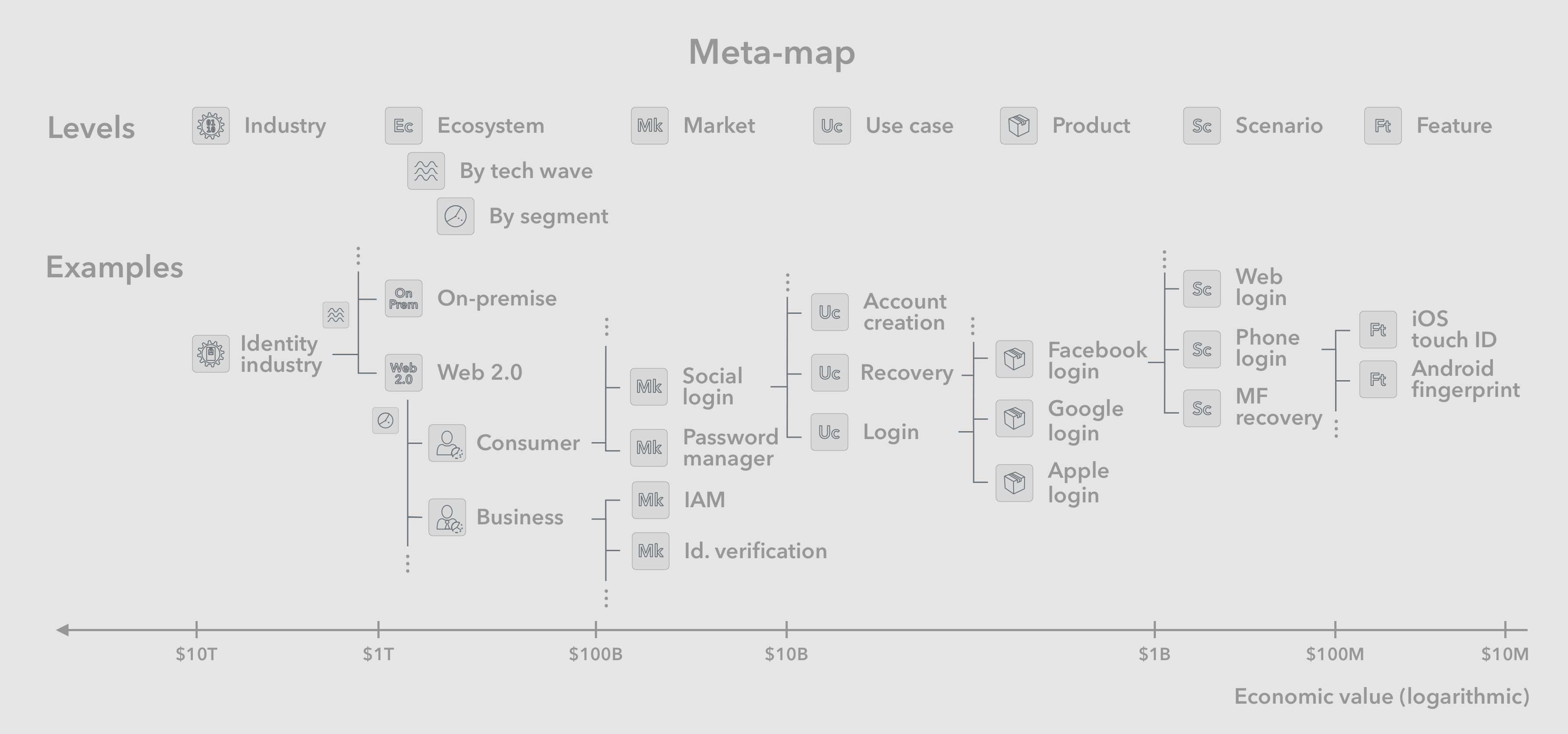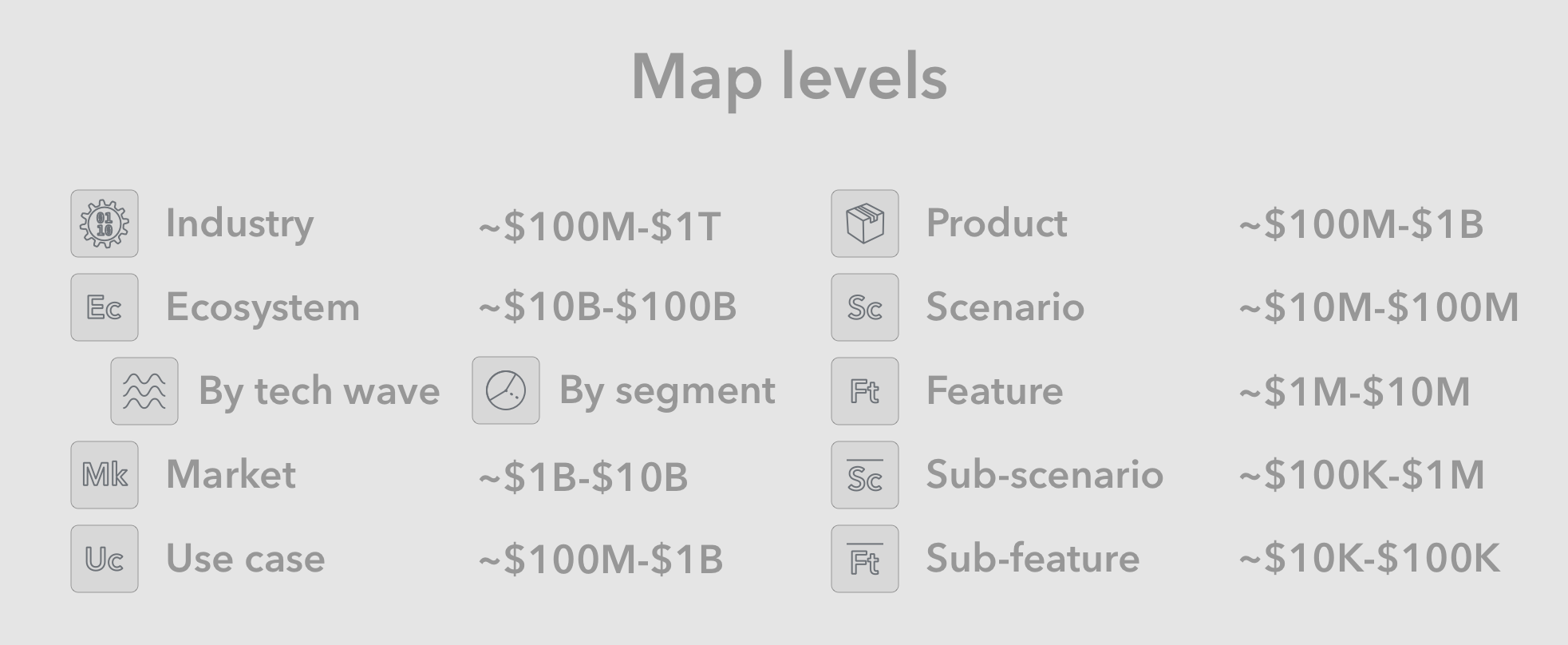Nima's notes

How to map an industry
Universal Identity has an inherent focus on human usability, which results in a unique mix of goals, ideas, and approaches to tackling the self-sovereign identity problem. However, and given this subjective point of view, we also strive to understand the world as objectively as possible.
Our effort first aims to build a detailed map of the identity industry and ecosystems, both of the historic and future versions, and with detailed drill downs into areas likely requiring significant evolution in future technology waves. Ultimately we have to understand the markets and ecosystems across multiple domains and disciplines.
This article formalizes the meta-structure (legend) of said map, through defining the concepts used in its composition. It also describes the multiple levels and layers of this map based on economic scales and disciplinary perspectives.
General methodology
Building the mentioned industry map is essential to our approach at Universal Identity. We take the following general approach to building understanding across a number of dimensions, as well as planning and building for the future:
- Problem - Formulate and iterate on a clear, concise and applicable problem statement. This can be achieved through, analyzing and modeling the ecosystem, markets, stakeholders, users and security, as well as understanding the what users and customers go through. As part of this effort we will have developed a multi-layer map describing the different aspect of the industry, ecosystems, markets, and products.
- Solution - Define a set of products, standards and business models, based on the understanding established above. Being armed with a clear map of the industry and ecosystems, allows for a more effective solution definition.
- Implementation - For each of the major ecosystem entities and their products, plan for operations, engineering, organizations and information dissemination. Start off the ecosystem by implementing the public organization’s products such as standards, reference information and source code, as well as helping any private vertical pieces required for initial usage.
Parts of these steps may occur in parallel or out of order, however the general sequence remains as shown above.
Meta-concepts
Here we define the concepts needed for building an objective meta-map of how our effort makes sense of the world. This high level perspective helps us understand and describe the different aspects of external reality, including markets and ecosystems, with the goal of formulating a plan to improve the vision of Universal Identity and increase the chances of success. Outside Universal Identity, this type of a meta-mapping can be also used to tackle any other industry, though here we specifically apply it to the identity system markets and ecosystems.
Domains
Domains refer to high level areas of knowledge and skills that have to do with differences in nature of the main subject matters, namely: humans, technologies and the economy.
- Human - The general discipline of design and humanities deals with humans as subjects, and accounts for their unique nature in its embedded areas of knowledge and skills. This set of skills is often represented in businesses by graphical or industrial design teams under product organizations.
- Technology - The general discipline of engineering aims to domesticate technologies and deal with their diversely unique natures, through its various sub-disciplines. These days, engineering organizations are a major source of competitive advantage in technology companies.
- [the] Economy - The economy can be defined as the greater set of economic interactions in human society, which are mostly monetary. It is the subject of endless policy and business strategy discussions. Disciples of the more general “business” discipline, seek knowledge and skills to understand, manage and interact with aspects of the economy. Sub areas include marketing, business development, strategy, organizational management, public relations, etc.

Many types of careers fit nicely within one of the above domains. One factor contributing to the above observation is the extended amount of time and resources required to master any discipline within a domain. Another factor is the fundamental differences in the nature of the domain’s subjects, which generally means that a disciple of each of these domains fits an approximate psychological profile. For example, those interested in understanding human beings are likely to become disciples of design or humanities.
Perspectives
Perspectives refer to the patterns and viewpoints used to understand and influence external realities. They often align with the individual disciplines represented in most major businesses, as well as reflected in organization structures at the leadership level. Below are the list of perspectives followed by the significant topics they encompass:
- Industry - Ecosystem, stakeholders, incentives, alliances, power dynamics, strategy/game-theory
- Market - Audiences, needs, wants, use cases, positioning, promotion, branding, pricing, psychographics
- Design - Personas, experiences, sentiment, brands, habits, mental maps
- Security - Expected outcomes, risks, vulnerabilities, damages, mitigations
- Product - Solutions, Products and services, interfaces, delivery, user-tasks, features, state and storage, specifications, support
- Standards - Protocols, definitions, registries, interoperation, governance
- Business model - Customers, agreements, transactions, income, costs, profits, pricing
- Operations - Procedures, logistics, projects, waste-minimization, scenarios
- Engineering - Architecture, infrastructure, building, fixing, upgrading, maintaining, monitoring, servicing, scenarios
- Organization - Vision, mission, culture, leadership, functional orgs
- Information - Concepts, structures, descriptions, contexts, instructions
- Narration - Founding myth, memes, media, public positions

Basic lenses
At the lowest level, most domains and and perspectives can be viewed and broken down using the elemental lenses described below. These are used to analyze and model the world and ultimately better predict future trends.
For example, the systems lens is the most prevalent way to look at the world when it comes to engineering. Or the design perspective takes advantage of the cognitive view when tackling user interactions and experiences.
Systems (mechanics) - A generalized systems-based view of analysis and modeling. It starts with viewing actors as systems that interact and which in turn have organized functional components. Economics- A generalized economics-based view of analysis and modeling. It starts with the view Cognition - A human view focusing specifically on state of human minds involved and the acts of interaction and communication between them. In most cases this view can further be broken down and recomposed back into the systems and economics views. Probability - Is a view focused on assigning probabilities to future and seemingly random events. It is the primary view used to build prediction models in order to invest wisely in future outcomes for highest returns.
Basic tools
These are the fundamental tools used in most or all of the various disciplines, in order to build an objective understanding of the area, and be able to reason about applying changes to them.
Analysis - Breaking down areas and systems into their parts based on environmental and historical data. The process helps identify independent variables attributed to specific agents or environmental forces, as well as starting to experiment with the outcomes of making changes to those variables.
Modeling - Understanding systems and their interactions with the world by modeling their components as well as interactions. This often involves recognizing the things, patterns, actors and behaviors that consistently describe those interactions, and building objective models of these. The models can in turn be tested for validity and usefulness as their output is compared to real world historical data.
Optimization - Determining a set of goals and metrics and optimizing a known model to maximize said goals and metrics. Maximizing profit for a business model can be one example of using optimization as a tool. Waste-minimization in an operational process can be considered as another example. Simplifying a user interface for minimal cognitive overhead is yet another example of its use.
Prediction - Enables more effectively planning for seemingly random future events. For example, optimizing on future economic outcomes are most effective when paired with a sound probabilistic model of outcome and formal prediction mechanisms. Of course these mechanisms will be based on historic data and assumptions that may prove incorrect, however probabilistically they give us the best odds given we iterate them following learnings from external data and assumption tests.
Meta-map
The map we are trying to put together is meant to encompass all levels of activity in the industry, starting from the very top level (industry itself), continuing to the various ecosystems, underlying markets and use-cases, and drilling down to the specific products, scenarios and features.
At all of these levels we will be able to apply the lenses, tools and perspectives discussed above, in order to build an even more comprehensive understanding.

Levels
As described above, the map will be hierarchical with multiple levels, which we have defined based on economic order of magnitude of the activities in a given subspace. The dollar calculation of this level of activity is for reference only, and only illustrates the idea of orders. It should not be considered as an accurate measurement in specific cases. See the levels used in the map below, followed by their estimated economic order of magnitude:
- Industry - $100B-$1T
- Ecosystem -by technology wave and/or segment - $10B-$100B
- Market - by solution or product category- $1B-$10B
- Use case - $100M–$1B - may be served by multiple competing products
- Product - $100M-$1B - may be satisfying multiple use cases
- Scenario - $10M-$100M
- Feature - $1M - $10M
- Sub-scenario - $100K- $1M
- Sub-feature - $10K- $100K

Industry
The industry scope represent the space of all activities related to a specific and related set of human needs, as well as all the businesses and offerings that add value in that general area. The greater space may encompass vastly different customers, modes of delivery and technologies, each of which will form a separate segment, ecosystem or technology wave.
For example, the identity industry pertains to all of the businesses and offerings that focus on adding value to the greater economy through the uptake, usage and support of identity systems. The space can be divided into the consumer, business and government segments, or separately separated based on the type of technology (digital, physical, etc) and technology wave (on-premise, web 2.0, etc).
Ecosystem - The ecosystem perspective focuses on the significant relations and interactions between the industry players. Technology wave - Trends, assumptions, etc
Market
The market scope represents the space of all activities meant to provide offerings for a specific set of use cases, within a given industry. The market will have providers on one side, and customers on the other, who in turn make the decision to purchase and use an offering. This may take the form of one or many solutions or products from various providers.
Segment -
Use case -
Product
Scenario -
Feature -
Entity
Entities represent the private goods or public goods organizations that may exist at various levels of the map.
For example, standards organizations are public good entities, that exist at the ecosystem level and help in developing that ecosystem by allowing market participants to benefit from predictable interoperability rules. Technology companies are often for-profit private goods organizations that focus on introducing products to one or many markets and each of which fulfills a given use case.
Worldview - Vision, mission, goals
Competencies -
Brand - Universal Identity - aspirational and descriptive name for a universally interoperable identity protocol enabling a large and increasing number of digital use cases. Charting a new territory
As part of proposing a solution to a problem at any of these levels, one has to provide detailed prescriptions on any missing pieces or changes in approach.
For example in the case of proposing a new wave of identity systems based on the decentralized digital wave of technologies, we have the opportunity to describe the essential pieces of such a new ecosystem, as well as prescribe the implementation of the parts that will kickstart it into existence with a high chance of solving the current wave’s problems.
Conclusion
There are a number of players in the new decentralized digital identity, all aiming to build a new identity layer for the internet. However we at Universal Identity believe this can only be achieved if it is positioned to serve the identity owners and their everyday digital needs, and is ultimately designed for usability and interoperability.
Given the scale of this ambitious goal, it would be irresponsible to operate without building an extensive and objective picture of the world and problems we are tackling. And so with this article we are building a map of the industry, describing the formalizing its meta-structure, and defining the concepts used in its composition.
This approach ultimately will enables a robust initial solution proposal, as well as subsequent iterations, to the self-sovereign identity problem. It results in advantages for charting new territory through planning and implementing said solution.